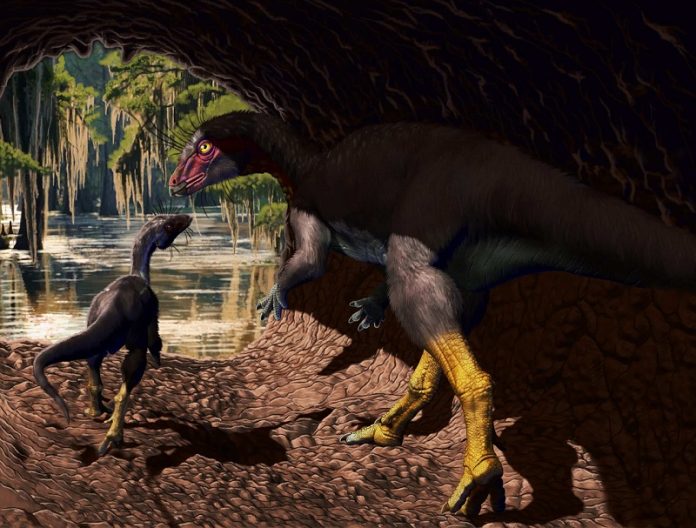
Dinosaurs didn’t just roam above ground; some lived below the surface too.
A newly discovered dinosaur species, Fona herzogae, shows evidence that these animals spent part of their time in underground burrows.
This new find helps us understand more about life during the mid-Cretaceous period, both above and below ground.
Fona herzogae lived 99 million years ago in what is now Utah.
At that time, the area was a large floodplain ecosystem with many rivers, situated between a massive inland ocean to the east and active volcanoes and mountains to the west. It was a warm, wet, and muddy environment.
Paleontologists from North Carolina State University and the North Carolina Museum of Natural Sciences discovered Fona’s fossils in the Mussentuchit Member of the Cedar Mountain Formation, starting in 2013.
The well-preserved fossils and certain features suggested that Fona lived in burrows.
Fona was a small plant-eating dinosaur, about the size of a large dog, with a simple body plan. It didn’t have the elaborate features of its relatives like horned, armored, or crested dinosaurs.
However, Fona had several anatomical traits similar to animals that dig or burrow. It had large bicep muscles, strong muscle attachment points on its hips and legs, fused bones along the pelvis for stability while digging, and proportionally larger hindlimbs than forelimbs.
Haviv Avrahami, a Ph.D. student at NC State and digital technician for the new Dueling Dinosaurs program at the North Carolina Museum of Natural Sciences, is the lead author of the study.
He explains that the fossil record tends to favor bigger animals because small bones often scatter, rot away, or get scavenged before they can be buried and fossilized. However, Fona’s fossils were often found complete and in good condition, suggesting they were buried in their burrows before death, making preservation more likely.
Lindsay Zanno, associate research professor at NC State and head of paleontology at the North Carolina Museum of Natural Sciences, agrees. She notes that Fona skeletons are more common in this area than expected for a small animal with fragile bones.
The best explanation is that they lived at least part of the time underground. Multiple Fona specimens have been found together, likely because they lived in burrows.
Although the researchers haven’t found Fona’s burrows, the tunnels and chambers of its closest relative, Oryctodromeus, have been found in Idaho and Montana, supporting the idea that Fona also used burrows.
The genus name, Fona, comes from the ancestral creation story of the Chamorro people, the indigenous populations of Guam and the Pacific Mariana Islands. In the myth, Fo’na and Pontan were explorers who discovered the island and became the land and sky.
The species name honors Lisa Herzog, the paleontology operations manager at the North Carolina Museum of Natural Sciences, for her invaluable contributions to paleontology.
Avrahami wanted to honor his Chamorro ancestors from Guam. In the myth, Fo’na became part of the land when she died, and new life sprang from her body, which relates to fossilization and creation. Fona was likely covered in colorful feathers.
Herzog discovered one of the most exceptional Fona specimens preserved together in what was likely a burrow.
Fona is also related to another famous North Carolina fossil: Willo, a Thescelosaurus neglectus specimen. Willo also had adaptations for a partially underground lifestyle, according to research published in 2023.
Avrahami believes Fona is key to understanding Cretaceous ecosystems better. Fona adds to the richness of the fossil record and shows the diversity of small-bodied herbivores, which are crucial but poorly understood components of these ecosystems.
Zanno points out that our understanding of dinosaur diversity has expanded greatly. Dinosaurs ranged from tiny tree-dwellers and nocturnal hunters to sloth-like grazers and even underground dwellers.
The research appears in The Anatomical Record. Other contributors include Peter Makovicky of the University of Minnesota and Ryan Tucker of Stellenbosch University.



